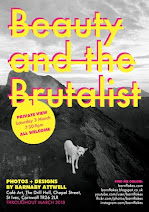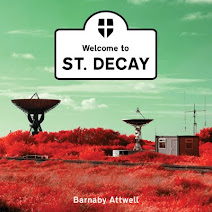From Frome Car Boot Sale
Journey Through the Secret Life of Plants Stevie Wonder (£3)
Mali Music Afel Bocoum, Damon Albarn, Toumani Diabete and Friends (£1)
John Lennon/Plastic Ono Band John Lennon (£2)
Money and Cigarettes Eric Clapton (£2)
From Head, Bristol
Happy Sad Tim Buckley (£1.99)
Kala M.I.A. (£2.99)
From Fopp, Bristol
Spiderland Slint (£6)
Raw Power Iggy and the Stooges (£3)
From Oxfam, Bristol
Let's Get Out Of This Country Camera Obscura (£3.99)
Beyond Even (1992-2006) Fripp & Eno (£4.99)
Preemptive Strike DJ Shadow (99p)
Sunday, January 31, 2010
Saturday, January 30, 2010
Louis Feuillade: Fantômas and Vampires

"Fantômas is the first great movie experience"
– David Thomson
"Feuillade's cinema is very close to dreams – therefore it's perhaps the most realistic"
– Alain Resnais
A glove made out of skin, a boa constrictor coming in through a bedroom window, blood spurting out of a wall, masks, disguises, stolen jewels, secret compartments, masked balls – welcome to the world of director Louis Feuillade (1873-1925).
Incredibly, Feuillade made over 800 films in his career, in every conceivable genre, but is most famous for his crime thrillers: Fantômas (1913-14), Les Vampires (1915-16) and Judex (1916-17). When first released, they were big hits with the masses as well as the intellectuals of the day – James Joyce, Jean Cocteau and the surrealists were fans (Kim Newman calls Fantômas 'pulp surrealism').
Fantômas is one of the first films to be adapted from a book (much like the Harry Potter of its day, there was a bidding war between the film studios to snap the book up – Gaumont offered the most cash). Written by Marcel Allain and Pierre Souvestre, apparently they wrote different parts of the serials without consulting one another – sort of like those drawings you did as a kid where one draws the top half of a monster, folds the paper over, another draws the bottom part without seeing the previous drawing – and you end up something unexpected and weird. The surrealists admired the Fantômas books partly because they liked the idea of automatic writing.
The Fantômas film serials were being produced as the books were still being published. They concern the exploits of an evil mastermind criminal, the eponymous sociopath Fantômas, and his gang, terrorising the bourgeoisie high society of Paris. Hot on his tail, always one step behind, is detective Juve and his sidekick, the journalist Jérôme Fandor.
Comparisons between Sherlock Holmes and his nemesis Moriarty have been made but are slightly inaccurate. Indeed, it is Fantômas who is more akin to Holmes with his disguises and intelligence, and Juve is more of a bumbling Watson figure: he never gets his man; Fantomas always gives him the slip – either through secret compartments, fake arms or clever disguises. One episode (Fantômas vs Fantômas) has Fantômas impersonate a 'famous American detective' Tom Bob, and has Juve accused of being Fantômas and put in jail.
Many of the elements have become the staple of crime detective fiction and beyond. Fantomas lay the foundations for everyone from Fritz Lang and Alfred Hitchcock to James Bond, but also, say, Luis Bunuel and David Lynch.
For what makes Fantômas unique (for its time and even now) is the blending of the mundane and the fantastic; the real and the surreal. Shocking, unexpected elements punctuate the seeming normality of the bourgeoisie domestic interiors (snakes; menacing, balaclavaed men all in black; sudden violence). The exterior shots too, all filmed on location, give a grey, dull realism to the often empty Paris streets, but a realism where terror is just around the corner (in reality, WW1 was just around the corner). Scenes have also been colour tinted to great effect, further enhancing the other worldliness (Joseph Cornell would do a similar thing with his experimental films to produce a dreamlike effect).
Scenes are reminiscent of Max Ernst's collage novels (one of which pictured above, right), such as La Femme 100 têtes (1929) and Une Semaine de Bonte (1934), where he transposed surreal elements onto traditional scenes from Victorian etchings to give a familiar yet otherworldly and poetic sensation.
Being an assault on the middle classes, Fantômas share much with film-maker Luis Bunuel. Indeed, some shots of Un Chien Andalou (1929) and L'Age d'or (1930) feel like they were lifted straight out of Fantômas. Bunuel would spend the next fifty years attacking petty bourgeoisie values – something Feuillade did pretty well in just a few years.
It's said there's no such thing as a silent film (live music was often as accompaniment in the early days – it's also said it's easier 'watching' a film with just the soundtrack rather than a film with no sound at all) and Fantômas is no exception. Classical music accompanies the film and the occasional sound effect has been added. The music helps immensely, but when Rossini came on, I was reminded of a Clockwork Orange, and then there's Wagner and that Tango from Un Chien Andalou – another reason why the Bunuel connection comes to mind.
Les Vampires isn't about vampires at all but a gang of villains called Les Vampires. Similar to Fantômas but perhaps not as iconic, it does nevertheless feature the scary/sexy-looking villain Irma Vep (not only an anagram of Vampire but also Im A Perv). The scene with her burgling an apartment wearing an all black body outfit is one of the most erotic of recent memory. There are other great scenes like the guests all being gassed at an evening ball (again, Bunuel comes to mind – when the guests are unable to escape, I thought of An Exterminating Angel), and the Vampires, covered head to foot in black, tiptoeing in over the bodies to steal the booty.
Feuillade saw that (as has been noted by David Thomson), unlike the Lumière brothers (who just wanted to film 'reality') or DW Griffiths (sentimental tosh), the cinema was a place for dreams... or nightmares.
Artificial Eye have released both Fantômas and Les Vampires on DVD.
Monday, January 25, 2010
Top 10 Film Critics
1. David Thomson
2. Derek Malcolm
3. Philip French
4. Pauline Kael (RIP)
5. Anthony Lane
6. Dilys Powell (RIP)
7. Alexander Walker (RIP)
8. Kim Newman
9. Geoff Andrew
10. Peter Bradshaw
2. Derek Malcolm
3. Philip French
4. Pauline Kael (RIP)
5. Anthony Lane
6. Dilys Powell (RIP)
7. Alexander Walker (RIP)
8. Kim Newman
9. Geoff Andrew
10. Peter Bradshaw
Sunday, January 24, 2010
Overheard #2
Strangers on a train.
– You know I'm seventy-six, love (boasts the man with the lager can in his hand, gnarled, side-of-a-matchbox stubble, glasses, but certainly not looking his age)
She ignores him.
– You know I'm a gypsy, love, a real gypsy. I bet you never seen a real gypsy before.
She still ignores him. Maybe he's a bit drunk, and somewhat racist against the Romani, who leave all their rubbish everywhere, he says.
– I'm going to Virginia Water, love. To see my boy. I haven't seen him in five years. Five years!
– [Pause] It's posh there, you know (ventures the woman).
– Eh?
He'd retired last week and now had some time to see his son.
– You know I'm seventy-six, love (boasts the man with the lager can in his hand, gnarled, side-of-a-matchbox stubble, glasses, but certainly not looking his age)
She ignores him.
– You know I'm a gypsy, love, a real gypsy. I bet you never seen a real gypsy before.
She still ignores him. Maybe he's a bit drunk, and somewhat racist against the Romani, who leave all their rubbish everywhere, he says.
– I'm going to Virginia Water, love. To see my boy. I haven't seen him in five years. Five years!
– [Pause] It's posh there, you know (ventures the woman).
– Eh?
He'd retired last week and now had some time to see his son.
Monday, January 11, 2010
R.I.P. Eric Rohmer (1920-2010)
French auteur Eric Rohmer died today, aged 89. Unswayed by fashion or taste, he made some 24 films over 50 years, most of which are low-key, naturalistic and literary. None of them contained sex or violence (though in Claire's Knee, when letch Jérôme finally touches Claire's knee, it's more exciting and erotic than any number of meaningless cinematic shags) and mainly featured young, affluent French folk discussing love and morals. They're great, but an acquired taste. In Night Moves, Gene Hackman says, 'I saw a Rohmer film once... it was kinda like watching paint dry.' Yeah, they're kinda like life (if you're young, French, middle class and intellectual).
I have fond memories of watching Claire's Knee (1970) with my girlfriend at the time, Clare. Naturellement, my hand was on her knee for most of the film.
I have fond memories of watching Claire's Knee (1970) with my girlfriend at the time, Clare. Naturellement, my hand was on her knee for most of the film.
Thursday, January 07, 2010
Film Dreams
I wish I was Al Pacino in Serpico, sitting outside in my overgrown garden on a summer’s day, with a freshly made pot of expresso coffee, long hair and beard, wooing the blonde next door.
I wish I was Gene Hackman in The French Connection II, alone in my hotel room on my first night in Marseilles, eating chocolate and loading my gun.
I wish I was hanging out with Barbara Hershey, reading her a bit of E E Cummings in my huge studio in Chelsea, New York, as in Hannah and Her Sisters.
Or I wish I was Jean Gabin as Pepe Le Moko, running through the black and white Delacroix Algiers Casbah in my spotless suit and spats.
...I met Isabelle Huppert in a dream, she was only nineteen and we ate strawberry ice cream.
I wish I was Gene Hackman in The French Connection II, alone in my hotel room on my first night in Marseilles, eating chocolate and loading my gun.
I wish I was hanging out with Barbara Hershey, reading her a bit of E E Cummings in my huge studio in Chelsea, New York, as in Hannah and Her Sisters.
Or I wish I was Jean Gabin as Pepe Le Moko, running through the black and white Delacroix Algiers Casbah in my spotless suit and spats.
...I met Isabelle Huppert in a dream, she was only nineteen and we ate strawberry ice cream.
Subscribe to:
Posts
(
Atom
)












